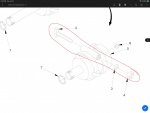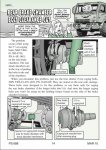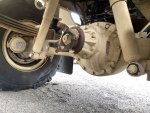There is a metallic oil line between the drivers side of the cylinder head and the back side of the governor. It is looped out like a diving board and it can oscillate, work-harden and break if the truck has a lot of vibration. Most people have been replacing it with a braided -4 hose with -4 JIC connectors and a couple of -4JIC to -4SAE adapters. some use off the shelf teflon brake lines or have a hydraulic hose made, just be sure to watch the bend radius of whatever hose you use. Here are the parts I chose. The 9” line allows me to just maintain the minimum 2” bend radius for the -4 braided line.
JIC Male to SAE Male Swivel-Right Angle Extra Long,JIC to SAE O-ring,Hydraulic Adapters & Fittings,Hydraulics, JIC 10 Male x SAE 10 Male 90 Degree
www.surpluscenter.com
JIC 4 Male x SAE 4 Male 45 Degree Elbow 6802-04-04 Adapter, JIC Male to SAE Male - 45 Degree, JIC 4M TO SAE 4M 45 ELBOW, JIC 4 Male x SAE 4 Male 456802-04-04,
www.surpluscenter.com
Buy Allstar Performance ALL46400-9 at JEGS: Allstar Performance Braided Steel Line #4 Line. Guaranteed lowest price!

www.jegs.com
proper driveshaft indexing has the yokes on each end of the shaft inline with each other. If someone pulled the slip yoke apart and wasn’t paying attention they could mis-align them. You also want to get under there and check the shafts for excessive looseness in the slip yoke splines. There is a hinging test that uses a magnetic base to connect a dial indicator to one side to measure the movement on the other side. it is a small spec, but basically if you can feel/see movement in the slip yoke it is probably too much...
these things have real high driveshaft angles and because of the axle gearing really high driveshaft RPM. The driveshafts need to be in good shape or they will provide vibrations that will destroy that oil line, alternator mounts or shake other parts loose like the air compressor, or crack the timing case. There is a support bracket you need to look for on the rear end of the air compressor where the power steering hydraulic pump is attached. It connects from the lower hydraulic pump mount screw in to the side of the engine block And helps to support all the overhung compressor and PS pump weight bolted to the aluminum timing case...
you need air to release the park brakes and what’s in the tanks will eventually leak away. If you have to flat tow with a truck that does not have rear air gladhands, you can cage the rear parking brakes. There should be “T” bolts in holders on each rear brake can that can be inserted in the end of the can to mechanically compress the park springs to release the park brakes if the truck has no air... The procedure to do it is in the manual and you can probably find a brake caging video on Youtube

probably should look to insure the caging bolts are in their holders when you are inspecting the truck...





